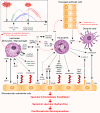Genome-wide expression profiling deciphers host responses altered during dengue shock syndrome and reveals the role of innate immunity in severe dengue
- PMID: 20652028
- PMCID: PMC2907396
- DOI: 10.1371/journal.pone.0011671
Genome-wide expression profiling deciphers host responses altered during dengue shock syndrome and reveals the role of innate immunity in severe dengue
Abstract
Background: Deciphering host responses contributing to dengue shock syndrome (DSS), the life-threatening form of acute viral dengue infections, is required to improve both the differential prognosis and the treatments provided to DSS patients, a challenge for clinicians.
Methodology/principal findings: Based on a prospective study, we analyzed the genome-wide expression profiles of whole blood cells from 48 matched Cambodian children: 19 progressed to DSS while 16 and 13 presented respectively classical dengue fever (DF) or dengue hemorrhagic fever grades I/II (DHF). Using multi-way analysis of variance (ANOVA) and adjustment of p-values to control the False Discovery Rate (FDR<10%), we identified a signature of 2959 genes differentiating DSS patients from both DF and DHF, and showed a strong association of this DSS-gene signature with the dengue disease phenotype. Using a combined approach to analyse the molecular patterns associated with the DSS-gene signature, we provide an integrative overview of the transcriptional responses altered in DSS children. In particular, we show that the transcriptome of DSS children blood cells is characterized by a decreased abundance of transcripts related to T and NK lymphocyte responses and by an increased abundance of anti-inflammatory and repair/remodeling transcripts. We also show that unexpected pro-inflammatory gene patterns at the interface between innate immunity, inflammation and host lipid metabolism, known to play pathogenic roles in acute and chronic inflammatory diseases associated with systemic vascular dysfunction, are transcriptionnally active in the blood cells of DSS children.
Conclusions/significance: We provide a global while non exhaustive overview of the molecular mechanisms altered in of DSS children and suggest how they may interact to lead to final vascular homeostasis breakdown. We suggest that some mechanisms identified should be considered putative therapeutic targets or biomarkers of progression to DSS.
Conflict of interest statement
Figures




Similar articles
-
The early whole-blood transcriptional signature of dengue virus and features associated with progression to dengue shock syndrome in Vietnamese children and young adults.J Virol. 2010 Dec;84(24):12982-94. doi: 10.1128/JVI.01224-10. Epub 2010 Oct 13. J Virol. 2010. PMID: 20943967 Free PMC article.
-
Patterns of host genome-wide gene transcript abundance in the peripheral blood of patients with acute dengue hemorrhagic fever.J Infect Dis. 2007 Apr 15;195(8):1097-107. doi: 10.1086/512162. Epub 2007 Mar 5. J Infect Dis. 2007. PMID: 17357045 Free PMC article.
-
Sequential waves of gene expression in patients with clinically defined dengue illnesses reveal subtle disease phases and predict disease severity.PLoS Negl Trop Dis. 2013 Jul 11;7(7):e2298. doi: 10.1371/journal.pntd.0002298. Print 2013. PLoS Negl Trop Dis. 2013. PMID: 23875036 Free PMC article.
-
Alternate hypothesis on the pathogenesis of dengue hemorrhagic fever (DHF)/dengue shock syndrome (DSS) in dengue virus infection.Exp Biol Med (Maywood). 2008 Apr;233(4):401-8. doi: 10.3181/0707-MR-198. Exp Biol Med (Maywood). 2008. PMID: 18367628 Review.
-
Autoimmune pathogenesis in dengue virus infection.Viral Immunol. 2006 Summer;19(2):127-32. doi: 10.1089/vim.2006.19.127. Viral Immunol. 2006. PMID: 16817755 Review.
Cited by
-
Lucidone suppresses dengue viral replication through the induction of heme oxygenase-1.Virulence. 2018 Jan 1;9(1):588-603. doi: 10.1080/21505594.2017.1421893. Virulence. 2018. PMID: 29338543 Free PMC article.
-
Joint ancestry and association test indicate two distinct pathogenic pathways involved in classical dengue fever and dengue shock syndrome.PLoS Negl Trop Dis. 2018 Feb 15;12(2):e0006202. doi: 10.1371/journal.pntd.0006202. eCollection 2018 Feb. PLoS Negl Trop Dis. 2018. PMID: 29447178 Free PMC article.
-
Dengue Virus Induces NK Cell Activation through TRAIL Expression during Infection.Mediators Inflamm. 2017;2017:5649214. doi: 10.1155/2017/5649214. Epub 2017 Sep 5. Mediators Inflamm. 2017. PMID: 29038620 Free PMC article.
-
Assessing the risk of dengue severity using demographic information and laboratory test results with machine learning.PLoS Negl Trop Dis. 2020 Dec 23;14(12):e0008960. doi: 10.1371/journal.pntd.0008960. eCollection 2020 Dec. PLoS Negl Trop Dis. 2020. PMID: 33362244 Free PMC article.
-
A Blood RNA Signature Detecting Severe Disease in Young Dengue Patients at Hospital Arrival.J Infect Dis. 2018 May 5;217(11):1690-1698. doi: 10.1093/infdis/jiy086. J Infect Dis. 2018. PMID: 29490079 Free PMC article.
References
-
- Gubler DJ. Epidemic dengue/dengue hemorrhagic fever as a public health, social and economic problem in the 21st century. Trends Microbiol. 2002;10:100–103. - PubMed
-
- Peters KG. Vascular endothelial growth factor and the angiopoietins: working together to build a better blood vessel. Circ Res. 1998;83:342–343. - PubMed
-
- Pang T, Cardosa MJ, Guzman MG. Of cascades and perfect storms: the immunopathogenesis of dengue haemorrhagic fever-dengue shock syndrome (DHF/DSS). Immunol Cell Biol. 2007;85:43–45. - PubMed
Publication types
MeSH terms
LinkOut - more resources
Full Text Sources
Other Literature Sources
Molecular Biology Databases
Miscellaneous

